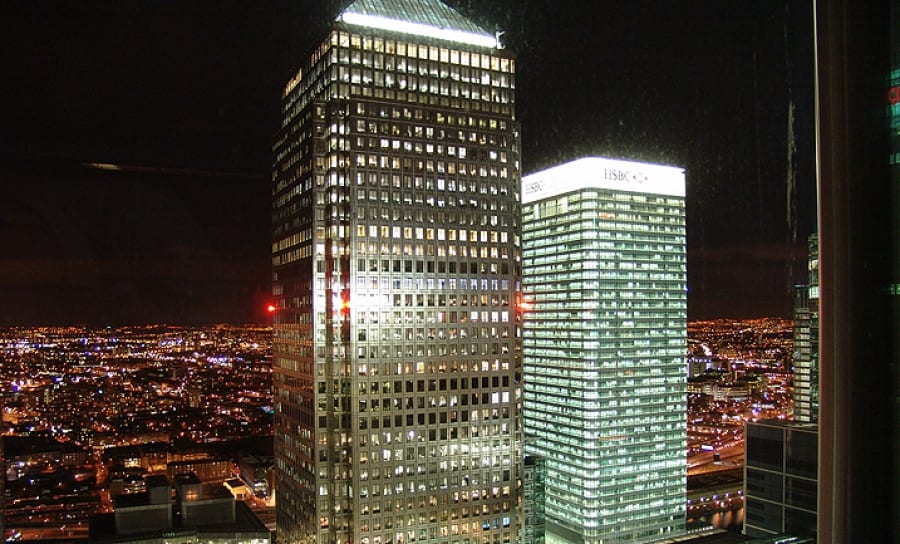 ||
||
A year on from the 20th anniversary of breaking ground in the Docklands, Elizabeth Choppin observes how the development came about , and what – if anything, will change post-crunch
It’s not surprising that Canary Wharf leaves some Londoners scratching their heads. As a place, it doesn’t particularly look or feel like it belongs in London, nor does it have any of the city’s higgledy piggledy charms. In fact, one might say it has the opposite effect – almost as if a North American city, a miniature Dallas, let’s say, has landed like an alien spaceship on top of what used to be the Docklands of east London, but is now part of another dimension.The reality, it could reasonably be argued, isn’t far off.
What was previously a wilderness of derelict industrial buildings centred on the old West India Docks has been, over a relatively short period of time, utterly transformed. Flash forward from 1988, when the foundation of One Canada Square was first laid down, and you now find a group of skyscrapers and concrete canyons home to one of the foremost financial centres in the world – a corporate workplace bubble with 1.4m sq m of office space, and a formidable rival to the Square Mile. Disused factories and warehouses have given way to bank headquarters and All Bar Ones and, from a certain perspective, the area has been successfully regenerated.
Yet, 20 years later, as the sun rose and set on the Docklands skyline, painting its towers that shimmering gold east Londoners had grown accustomed to seeing, the irony was painfully clear. Almost overnight, Canary Wharf had morphed into a symbol for what was going spectacularly wrong. With banks folding and the economy collapsing under us like so many wooden toothpicks, the light atop the tallest building in the UK now flashed like a warning sign and the questions sprouted up like mushrooms. Is Canary Wharf as outdated as the boom-and-bust financial model it had supported for two decades, and how will it change in light of the downturn, if at all? Are we comfortable with the precedent it has set for new developments in London and other parts of the UK? And most significantly, why does it feel so… artificial?
Of course there are no immediate answers to these questions but going back to the beginning helps to make sense of Canary Wharf as a place, which has been controversial from the point the Isle of Dogs was designated an ‘Enterprise Zone’ in the early 1980s. Local people felt inherently suspicious of it. Others were (and still are) dubious of the political context that gave it shape. Still, despite this and the collapse of the commercial property market in the early 1990s, it gathered momentum and eventually was accepted as a necessary evolution in London office design – a flagship for a new British economy.
Transport links came in and more office towers went up in Churchill Place, Canada Square, North Collonade, Bank Street and beyond. Banking giants including Barclays, HSBC and Citigroup, plus major media companies such as Reuters and The Independent also made Docklands their home.
“Canary Wharf was brilliantly timed,” says Frank Duffy, architect and founder of the workplace consultancy DEGW. “Suddenly it was possible to shift money around the world at lightning speed and London was terribly short of good office space. It was a time of great excitement and things moving forward.”
Following the deregulation of the London Stock Exchange in 1986, the financial services industry throttled forward and needed the architecture to accommodate it. Global investment banks required vast floor plates to conduct business – and property developers were chomping at the bit.
Docklands had more or less lain dormant for a decade and it was here that the Thatcher government encouraged growth via one of its (now defunct) Urban Development Corporations (UDCs) – public bodies, often chaired by property developers, which could give tax breaks and drastically loosen planning permission in designated areas for regeneration. This meant that vast areas of cities, in this case Docklands, could be lumped together and owned privately, with very little planning restrictions on new buildings. The result is a kind of city within a city, and may be a core reason why Canary Wharf is criticized for not being properly integrated into its surroundings.
According to Anna Minton, author of the recently published Ground Control, a book examining the impact of privately owned developments on UK cities, these UDCs laid the framework for Canary Wharf and what she calls “the architecture of extreme capitalism”, which has popped up in Newcastle, Liverpool, Bristol, Leicester and other ‘regenerated’ industrial areas around the country.
Minton’s main argument is that this most recent financial meltdown is a time to take stock in places like Canary Wharf. Does it deliver what we need in business and as a society?
“There is a very stark division between Canary Wharf and the Isle of Dogs – that was predicted when it was put into place,” says Minton. “The whole premise of Thatcher’s ‘Trickle Down’ theory to the sections of the community who need it is a complete fallacy.
“My main problem is this is the model for every new development around the country. It’s an economic model that doesn’t work – it’s based on debt, high rents and service charges. I’m not saying Docklands should be repopulated by artists’ studios and roof gardens – but we do need to admit to ourselves that there is a big problem with the way we’re doing things. I don’t think we should blindly follow in its footsteps.”
Beyond the philosophical argument, there is no doubt that Docklands has proved vulnerable to economic shock. Its first owners, Olympia and York, had to be rescued from bankruptcy in 1992 and the development was severely affected by a financial downturn at the beginning of the noughties.
The recent figures also paint a picture of uncertainty. According to James Roberts, head of research for letting agents Knight Frank, vacancy rates in Canary Wharf are running at 11.9 per cent, which is quite a rise from Canary Wharf Group’s own figure at the end of 2008 of .03 per cent. Roberts adds that rental values for prime space have dropped 30 per cent (from £50 to £35 per square foot) from their peak in 2007.
“When the banks were expanding, they were taking really large chunks of space, and now there is more space coming onto the market than is coming off,” he says.
Kelvin Davidson, property economist for Capital Economics, predicts that rental values across the city of London, including Canary Wharf, will fall further because of low demand and a surplus of space.
What’s more, tenants are using space more efficiently. Paul Statham, managing director for RNM Systems, which produces Condeco, a workplace management software, says his company’s turnover has risen by 80 per cent in the last year. Three major banks in Canary Wharf, including Barclays, have employed RNM to help them better manage their space. Another RNM client reduced their space by half, says Statham.
“The cost savings are obvious if you don’t have to buy another office building when you’ve reached capacity,” he says. “We have lots of clients that have looked at their real estate and had to reassess – you simply can’t afford to have empty office space, so you have to reduce it.”
Some of this is down to a new approach to work, he adds. “People don’t need a desk, the culture has changed and I think going into the next five or ten years, they won’t need to have a physical presence – they can have a virtual presence.”
But as a spokesman for Canary Wharf Group was keen to point out, in the midst of the disintegration of Lehman Brothers, a £237m deal was secured with JP Morgan, which is due to develop a building in Docklands for its European headquarters to be completed in 2012.
Nomura’s announcement that it will move out of Canary Wharf and into the City next year does come as a blow despite Canary Wharf Group’s four- year insurance cover for potential rent defaults. It raises the question of whether some firms would like to disassociate themselves with Canary Wharf following the financial collapse.
A Nomura spokesperson said the decision to move “was the final step away from the transaction a year ago” (meaning the demise of Lehman Brothers, where Nomura acted as administrators) but also that the City was “more convenient” and “made more sense”.
So how will all of this uncertainty affect things like leases? Knight Frank’s Roberts expects lease lengths to be more flexible, and likely shortened for sublets as occupants expand and contract depending on the economy. Kelvin Davidson adds: “People signed into long leases aren’t going to break them although more and more are opting for break clauses, and that ups the risk of losing tenants.”
“The weakness of a development like Canary Wharf is that those buildings were designed in a tradition of mono-functionality – they’re brittle”
Interestingly, shorter leases and dropping rents mean a potential diversification of occupants – which could add a new texture to life at Canary Wharf, and possibly a welcome one. Advertising, construction, media, IT and public sector organisations including the 2012 Olympics organisers, Crossrail and a branch of the Metropolitan Police have leased space: “You are seeing some new tenants moving into the Wharf – but you couldn’t say that the new activity is compensating for the losses during the financial crisis,” Roberts reminds us.
Still, the financial crisis has halted several large-scale building projects in other parts of London, and a sharp decline in planning them, which implies that in a few years there might be a shortage of office space – and therefore a development like Canary Wharf is well positioned to reap the benefit.
Davidson agrees: “There will be a point when much of that vacant space is absorbed and rental values will rise again – and developers will respond by building. History shows that legs are built into the system – it’s all very cyclical.”
However, Songbird Estates Ltd, CWG’s majority shareholder, was forced to refinance last month so as not to breach Citi loan covenants of £880m.
So is it good news or bad news for Canary Wharf? It’s still a question for those hoping the credit crunch would induce a radical change in the commercial property market and the industries that fuel it.
Paul Burgess, a director for British Land, believes that the systemic changes happening now, ‘post-crunch’, could potentially have a profound impact on the next generation of office buildings in London. Floor plate size, configuration and specification will all be influenced by the needs of a wider net of occupiers, he says, and the possibility of a more regulated financial industry would mean a new approach to designing buildings.
It’s a shift that Frank Duffy would welcome, although he questions whether it would go far enough to accommodate a whole range of patterns of use within the ‘knowledge economy’. Existing office buildings are a redundant idea, he suggests, and are not sustainable in the long run. In the future, successful buildings will be more permeable and able to shift, for example, from office, to flats, to retail – and will complement and engage with their surroundings more than now.
“The weakness of a development like Canary Wharf is that those buildings were designed in an architectural tradition of mono-functionality. They do one job, they’re brittle – they can’t accommodate change,” Duffy explains. The developers got it right at a certain moment in time, he says, but we need to ask ourselves what happens after ten, 20 or even 75 years and how these buildings can potentially be used in other ways.
“The genie is out of the bottle. You do not have to go to work to work,” he says. “The question is how do you justify ‘place’ in an increasingly technologically connected world? Now you have highly mobile people who are not working in the patterns of the 20th century. Which formula would you put your money on for the preferred model of the 21st century? I don’t think that model is Canary Wharf or any office building as we know it.”





















